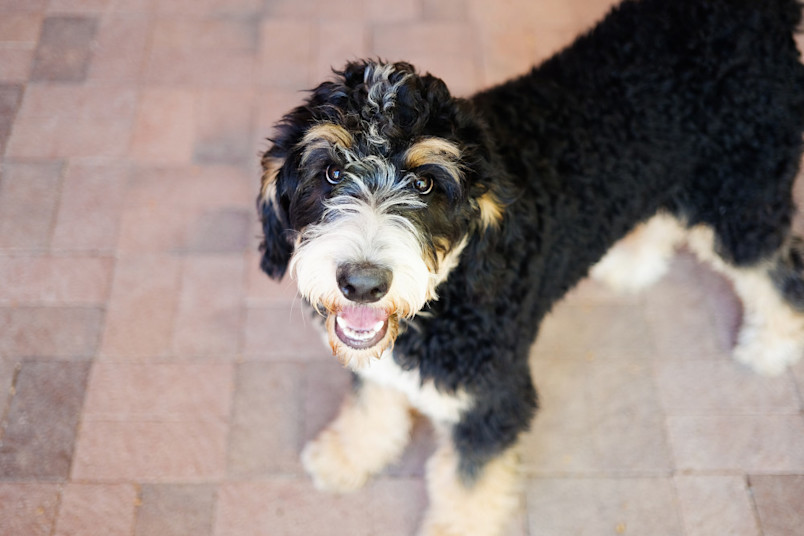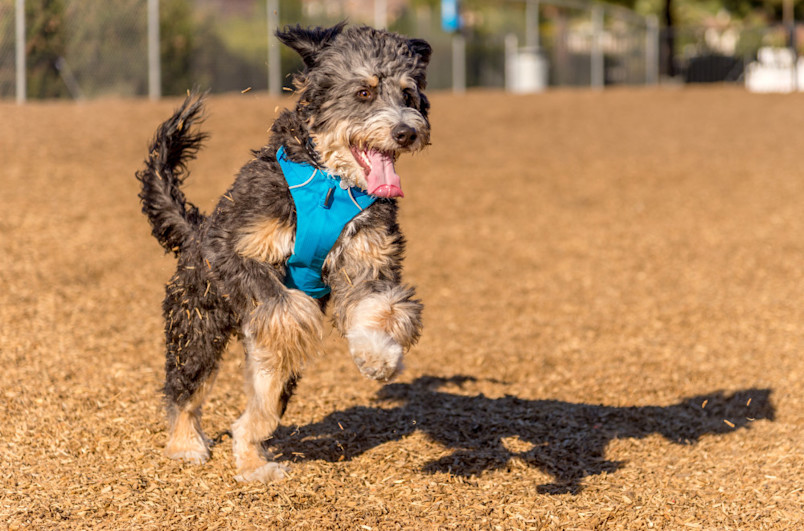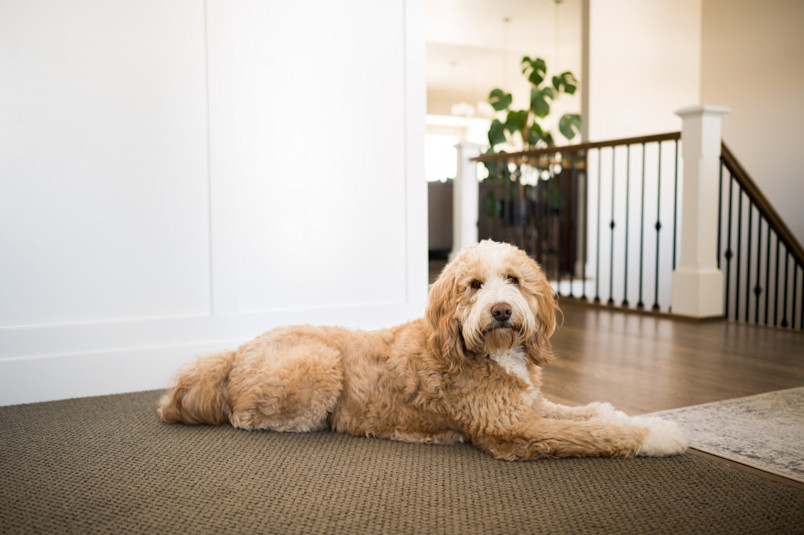
It seems that poodles are crossed with nearly every other breed these days—with good reason! Poodles aren't just known for their fancy haircuts – they're also low-shedding, intelligent, and easy to train. When crossed with other dogs, poodles can bring these very desirable traits with them. A prime example of this perfect pairing? The Bernedoodle.
Bernedoodles are a cross between Bernese Mountain Dogs and poodles, creating a friendly, fun-loving, low-shedding canine companion. Depending on which type of poodle this cross originates from, they can be large like a Bernese, or more compact coming in mini and toy versions.
Quick Facts
Name: Bernedoodle
Origin: 2003 in Canada.
Size:
Standards- 60-100 lbs and about 30” tall
Mini- 20-45 lbs and 20-22” tall
Toy- under 20 lbs and 12-18” tall
Lifespan: 12-18 years with standards tending to have shorter lifespans than minis and toys
Appearance: Tri-colored, black and white, black and brown, or black with medium length, wavy hair. They may be large and beefy like the Bernese or more slender like a poodle.
Temperament: Goofy, fun-loving, active and loyal.
Compatibility: If given enough exercise, training, and socialization, these dogs tend to fit in with just about any family. Socialization and training will be necessary to be around other pets and kids simply because they can be large and unintentionally rough.
Intelligence: The poodle is one of the most intelligent breeds and this cross tends to take after them. They learn quickly, but without proper training can use that intelligence in negative ways.
Exercise and energy: Bernedoodles are active dogs, they require a few hours of exercise, both physical and mental, per day.
Grooming: Regular brushing to prevent mats and tangles. Weekly brush outs are the minimum that needs done.
Training: These dogs tend to be highly intelligent so they learn quickly, but this means they can also learn bad habits quickly as well. Proper and consistent positive reinforcement is the best way to ensure a bernedoodle uses their intelligence for good.
Health: Hip and elbow dysplasia, progressive retinal atrophy, and allergies
Highlights: This intelligent yet goofy breed is sure to make a great companion.
What Makes Bernedoodles Great?
Great for outdoor enthusiasts and active families
Tend to be fairly healthy
Low shedders, but do require regular brushing
Have three different size categories to suit nearly any living situation
What do Bernedoodles Look Like?
Since Bernese Mountain Dogs and poodles have very different appearances, you can imagine that a bernedoodle can display varying traits. They may closely resemble the Bernese in coloring and size but with a poodle hair texture, look more like a solid-colored poodle, or fall anywhere in between.
Bernedoodle Size
A bernedoodle’s size will depend on the poodle they’re crossed with. One with a standard poodle parent will tend to be larger, between 70-90 pounds and 24”-30” tall. Minis and toy crosses will be smaller, with minis coming in between 25-50 pounds and toys under 20 pounds. They may be more robust like a Bernese or long and lean like a poodle.
Bernedoodle Haircoat
A bernedoodles haircoat may show up with colors and textures that span the board. They may have the classic tri-color appearance of a Bernese or be a solid black, brown, or white like a poodle. They tend to have at least wavy, if not curly hair similar to a cavapoo, and will typically be low shedders.

What are Bernedoodles Like?
It’s hard to resist the goofy, fun-loving personality of a Bernese Mountain Dog. Few could argue. However, if you sprinkle in a little of a poodle’s intelligence, then you’ll have a pup that could rival any of the best family dog breeds. These playful pups inherit the family-friendly personality of their Bernese parent, while the Poodle influence makes them eager to learn and eager to please. The result? A furry friend who's not just adorable, but also a joy to have around the whole family.
Bernedoodles Personality
Here’s a dog that loves and lives to be with their humans, one of the characteristics of a bernedoodle that’s hard to beat. They’re typically friendly, loyal, exuberantly happy, and energetic. They’re also smart and willing to learn but can use that intelligence for negative behaviors if they’re not trained correctly. Engaging training and mental stimulation are key to unlocking their full potential and preventing boredom-induced mischief.
How are Bernedoodles with Children and Family?
Bernedoodles, known for their love and loyalty, can be wonderful family companions. However, each dog is unique. Early socialization with children and responsible pet ownership are key to building lasting bonds. While playful and gentle, their size and energy require management. By understanding your bernedoodle's individual needs and prioritizing training and socialization, you can create a happy, harmonious family for everyone.
What About Other Animals?
Most bernedoodles will willing take on a furry companion, just make sure to supervise interactions from the start to ensure the bernedoodle’s playfulness isn’t off-putting for the other critter.
How to Care for a Bernedoodle
A bernedoodle’s personality may make them seem like they’re just another human member of your family, but they do still need some specialized care. Most of that care is going to come in the form of exercise, grooming, and training.
Bernedoodle Grooming Needs
Being classified as a low-shedder does not mean your house will be dog hair-free. Instead, it means you’ll need to take time for regular brushing to help prevent mats and tangles. Most bernedoodles will do well with a thorough brushing once or twice a week with baths every 4-12 weeks. Some may require a little trimming around the face and feet as well.
Trim their toenails every couple of months or as needed, clean their ears with every bath and as needed in between, and brush their teeth at least once a week to help prevent dental disease.
How to Train a Bernedoodle
Bernedoodles are intelligent, making them easy to train, which is a good thing, but it also means they can take advantage of a novice dog owner. Their smarts may make them easier to train than some other dog breeds, but they need to be challenged to stimulate their mind daily. Learning obedience or tricks can help provide that stimulation, just be sure to remain consistent in your demands and rewards. Bernedoodles that don’t get enough mental stimulation may resort to negative behaviors like becoming destructive or barking.
How Much Space do Bernedoodles Need?
Another big plus for this combination is the ability to have a bernedoodle that’s small enough for apartment living or one that’s large enough to explore the great outdoors with you. No matter the size, most bernedoodles are adaptable and can take on apartment living provided that they get plenty of daily exercise. We’re talking a couple hours of a mix of walking, hiking, or running and some obedience training or playtime with you.
What do You Feed a Bernedoodle?
Like any other dog breed, bernedoodles do best on a high-quality dog food with real meat as the first ingredient. Talk to your vet about how to choose the best dog food for your specific bernedoodle. Keep in mind that the larger members of this group are going to eat a lot, so your dog food bill could add up to a formidable expense throughout their lifetime.

Bernedoodle Health Issues
Fortunately, these curly-coated loves tend to be fairly healthy, typically far healthier than their parent breeds. However, that doesn’t mean they’re totally out of the woods health-wise. Getting your bernedoodle from a good dog breeder is key to preventing many of these issues as there are screening tests available.
Hip and Elbow Dysplasia
Dysplasia means abnormal growth or development and it’s typically coupled with a specific joint. It just so happens that some dog breeds, mainly larger ones including the bernedoodle, are more riddled with both hip dysplasia and elbow dysplasia. Both conditions can be very painful and impact a dog’s mobility, so it’s important to make sure breeding animals are screened before producing offspring.
Ocular Diseases
If debilitating joint issues aren’t enough, bernedoodles may also have a higher rate of developing problems with their eyes. Hereditary cataracts and progressive retinal atrophy can both lead to blindness, so it’s important to seek veterinary care if you suspect any issues with your bernedoodle’s eyes.
Skin Issues
With a thick, curly hair coat, a bernedoodle may have an increased risk of skin issues such as hot spots or dermatitis. They may also struggle with allergies that can lead to itchy, dry skin or recurrent ear infections. Skin issues tend to be lifelong battles, so be prepared to help your bernedoodle fight these for a long time.
Importance of Insurance for Bernedoodles
While bernedoodles are a relatively healthy cross, many of the issues that they do develop tend to need lifelong treatment. Dog insurance can be a valuable tool to manage these costs. While the upfront premiums might seem significant, consider the potential savings it offers throughout your pup’s life. Remember, early coverage helps avoid pre-existing condition exclusions. Weigh the long-term benefits against the monthly cost to ensure peace of mind when caring for your beloved bernedoodle.
Conditions like hip dysplasia, allergies, or certain eye diseases can require specialized care, medications, and even surgeries, quickly racking up significant expenses. Pet insurance helps offset these costs, providing peace of mind and ensuring your furry friend receives the best possible care without straining your budget.

History of Bernedoodles
The bernedoodle is a relatively new cross with its origins in 2003. The idea was to add the intelligence of the poodle to the loyalty and fun-loving spirit of a Bernese. The cross typically creates just that with the low-shedding quality thrown in there as well.
Since bernedoodles are the cross of two purebreds, they’re not actually recognized as their own breed by many dog organizations including the American Kennel Club (AKC).
Getting a Bernedoodle
You may find it hard to come across one of these dogs due to their relative newness, meaning that you’ll typically have to go straight to the source by finding a breeder. But that doesn’t mean that there aren’t some to be found in shelters or rescues, so try doing some research and have some patience if you’re interested in adoption instead.
When choosing a breeder, make sure to pick one that’s done their homework. They should know both breeds inside and out to produce the healthiest cross possible. This means getting screening tests for dysplasia and other common issues and only breeding those dogs that are healthy.
Bernedoodle FAQs
How much does a bernedoodle cost?
This is a rare combination, so you’ll likely end up paying upwards of $3,000-$4,000 for a puppy from a breeder. If you’re able to find one for adoption, the cost should be significantly less.
Do bernedoodles bark a lot?
Bernedoodles tend to be fairly quiet overall. Because of this, they aren’t known to be good guard dogs, in fact they may be overly friendly, even to strangers.
Are bernedoodles good house dogs?
Bernedoodles like to have the best of both worlds—they are active and love outdoor adventures, but they also like to snuggle on the couch. Even larger members can do well in an apartment if given proper daily outings, but they may prefer to have at least a small, fenced enclosure.